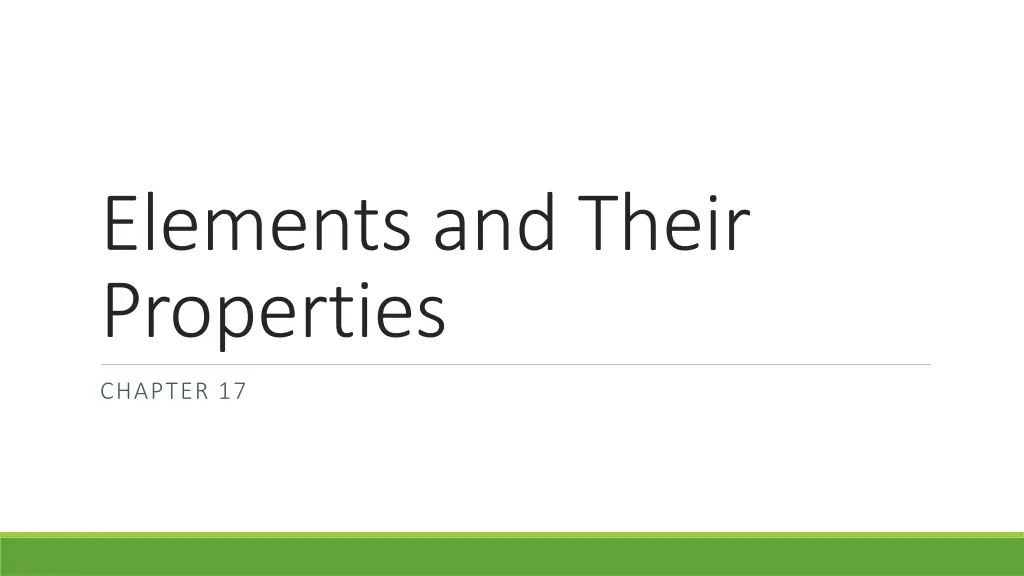
Periodic Table Elements and Properties
Explore the periodic table with information on elements, groups, families, periods, metals, bonding, and specific groups like alkali metals and alkaline earth metals. Learn about the characteristics and properties of different elements in an interactive way.
Uploaded on | 0 Views
Download Presentation

Please find below an Image/Link to download the presentation.
The content on the website is provided AS IS for your information and personal use only. It may not be sold, licensed, or shared on other websites without obtaining consent from the author. If you encounter any issues during the download, it is possible that the publisher has removed the file from their server.
You are allowed to download the files provided on this website for personal or commercial use, subject to the condition that they are used lawfully. All files are the property of their respective owners.
The content on the website is provided AS IS for your information and personal use only. It may not be sold, licensed, or shared on other websites without obtaining consent from the author.
E N D
Presentation Transcript
Elements and Their Properties CHAPTER 17
Elements https://www.youtube.com/watch?v=VgVQKCcfwnU
Name of Element Atomic Number Chemical Symbol Atomic Mass
Groups/Familiesvertical columns of the Periodic Table Alkali Metals Halogens Noble Gases Alkaline Earth Metals
Groups/Familiesvertical columns of the Periodic Table Transition Metals Inner Transition Metals
PeriodsHorizontal rows of elements in the Periodic Table. 1 2 3 4 5 6 7
Metals Solid at room temperature Shiny Ductile Can be drawn into thin wires Malleable Can be hammered into very thin sheets Good conductor of heat and electricity
Metals Metals can participate in 2 types of bonding Bonding with NONMETALS (called IONIC bonding) Metals will lose electrons therefore become a positive ion Nonmetals will gain electrons therefore become a negative ion Metallic Bonding Positively charged metallic ions are surrounded by a sea of electrons Valence electrons are not held tightly to the nucleus of the metal atom but move freely among many positively charged ions
Alkali Metals Group 1 elements on the periodic table Silvery appearance Soft enough to cut with a knife MOST reactive of all metals extremely reactive Contains 1 valence electron (outermost energy level) Creates a +1 charge (wants to lose 1 electron)
Alkaline Earth Metals Group 2 elements on the periodic table Harder than alkali metals Not found as free elements in nature --- found as compounds in the earth s crust Contains 2 valence electrons (outermost energy level) Creates a +2 charge (wants to lose 2 electron)
Transition Metals Elements in groups 3 through 12 on the periodic table Less reactive that metals in group 1 and 2 Share similar properties conductivity, luster, malleability, bp, mp Inner Transition Metals Fit within the transition metals on the periodic table The Lanthanides first row of the inner transition metals The Actinides second row of the inner transition metals
REVIEW Classify the following as alkali metals, alkaline earth metals, transition elements, or inner transition metals: Calcium Gold Iron Magnesium Potassium Sodium Uranium Suppose you discovered a new element with 120 protons and 2 electrons in its outer level. In what group does this new element belong?
Nonmetals Elements that are usually gases or solids at room temperature Poor conductors of heat and electricity Solid nonmetals brittle or powdery Right side of stair step
NONMETALS Nonmetals can participate in 2 types of bonding Bonding with METALS (called IONIC bonding) Nonmetals will gain electrons therefore become a negative ion Bonding with other Nonmetals (called COVALENT bonding) Bonding with other nonmetals only Share electrons (no ions formed)
Hydrogen Hydrogen is a nonmetal, even though it is on the left side of the periodic table Hydrogen is a diatomic molecule molecule that consists of two atoms of the same element in a covalent bond
Halogens Group 17 Very reactive because they are trying to gain one electron They have 7 valence electrons only one electron needed to complete its outer energy level They have a -1 charge (they want to gain one electron) Form compounds with metals (salts combination of a metal and a halogen)
Noble Gases Group 18 Unreactive Stable because their outermost energy levels are full (8 valence electrons)
The Noble Gases http://www.youtube.com/watch?v=QLrofyj6a2s
Review Identify the nonmetal in these compounds MgO NaH AlBr3 FeS Explain why the noble gases are unreactive.
Mixed Groups (Metalloids) Have some properties of metals and nonmetals All solids at room temperature Malleable Brittle Used as semiconductors in circuitry for computers, televisions, etc.
The Boron Group Group 13 First element (Boron) is a metalloid the rest are metals Contains aluminum the most abundant metal in the earth s crust All contain 3 valence electrons Create a +3 charge (they want to lose 3 valence electrons)
The Carbon Group Group 14 Carbon nonmetal; Silicon and Germanium metalloids; Tin and Lead metals All contain 4 valence electrons Can create a +4 or -4 charge (depends who they bond with), however they will mostly share electrons and form covalent bonds
The Nitrogen Group Group 15 Nitrogen and phosphorus nonmetal; arsenic and antimony metalloids; bismuth metal All contain 5 valence electrons Create a -3 charge (because they want to gain 3 electrons)
The Oxygen Group Group 16 Oxygen, sulfur, selenium nonmetal; Tellurium metalloid; polonium metal All contain 6 valence electrons Create a -2 charge (because they want to gain 2 electrons)
The Nitrogen Group Group 15 Nitrogen and phosphorus nonmetal; arsenic and antimony metalloids; bismuth metal All contain 5 valence electrons Create a -3 charge (because they want to gain 3 electrons)
